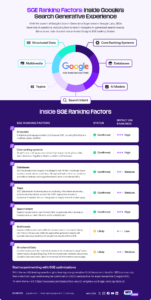With the launch of Google’s Search Generative Experience in Google Labs, SEOs have lots of questions, including how to rank in Google’s AI-generated search results. So, our team dug in and did the research to get answers.
Below is our data-backed research into Google’s SGE ranking factors.
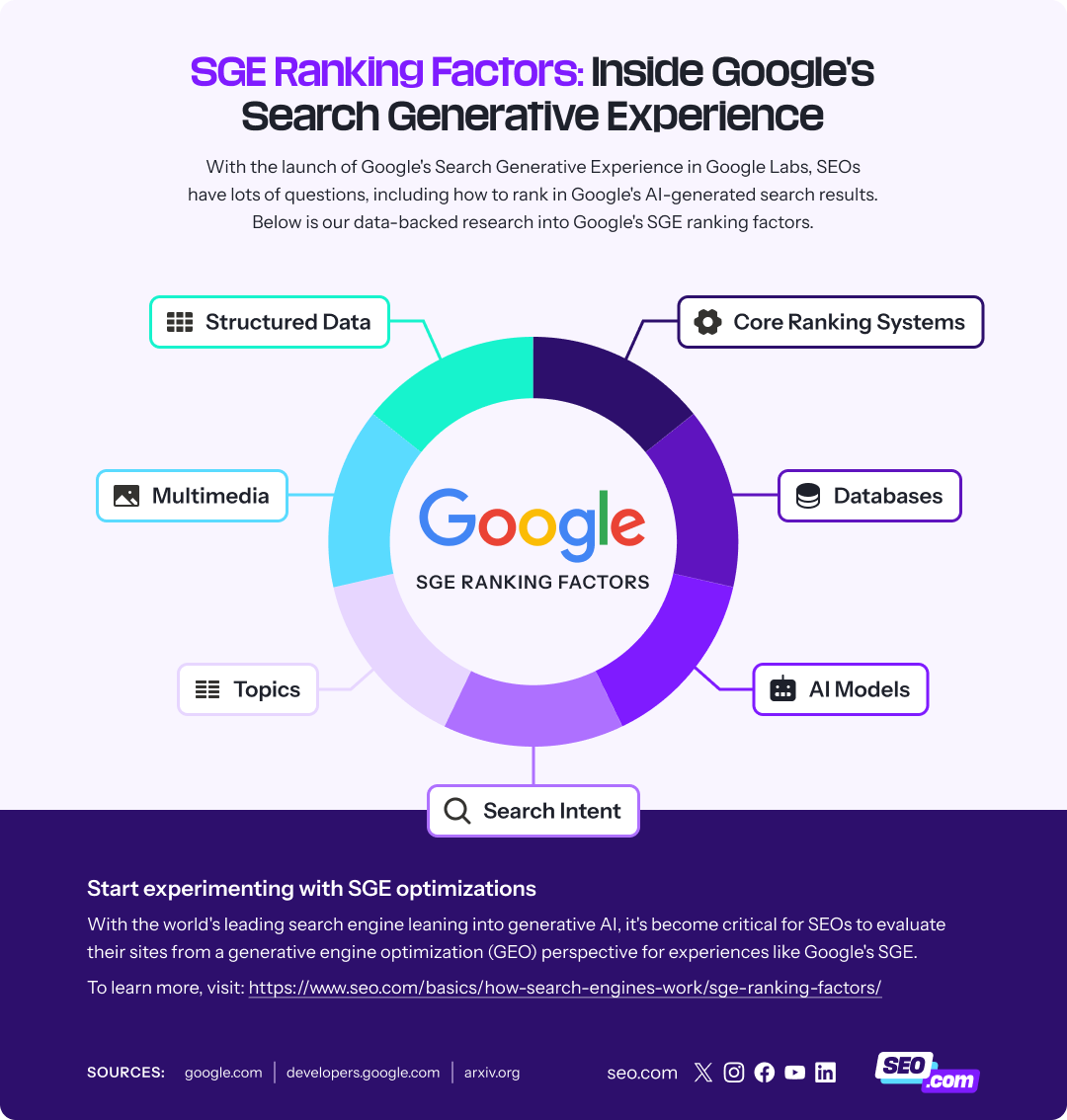
Download the full Google SGE Factors infographic here
How did you determine Google’s SGE ranking factors?
Like our research into Google’s search algorithm, we dug into official documents, academic studies, and experiments to determine what powers Google’s Search Generative Experience — WebFX (the team behind SEO.com) has also started SGE optimization, as shown below:
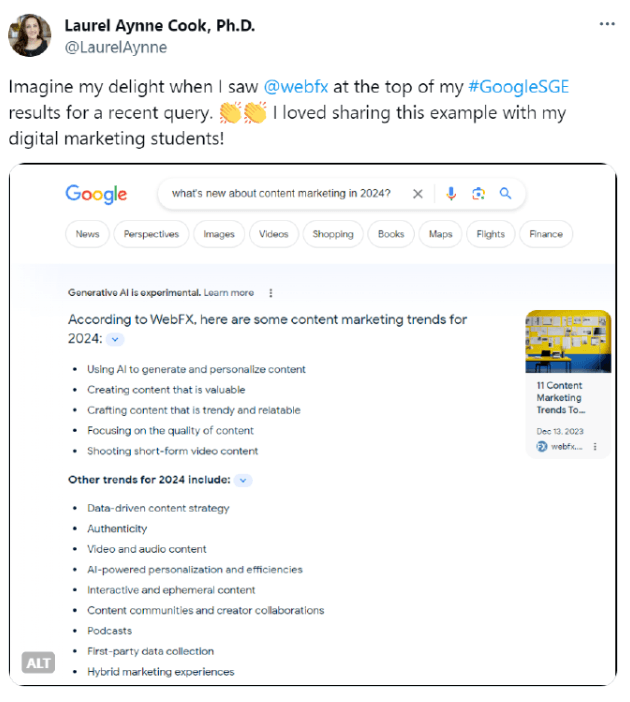
However, it’s critical to mention that SGE is not publicly available.
The technology is only accessible through Google Labs, Google’s testing ground for search experiments. That means SGE is subject to change rapidly, which can impact the ranking factors listed below.
Google’s SGE ranking factors
From our research, we discovered seven areas that power Google’s SGE ranking factors:
- AI models, like PaLM 2, MUM, and Gemini
- Core ranking systems, including Helpful content, PageRank, and Reviews
- Databases, like Google Shopping Graph and Knowledge Graph
- Topic, such as Your Money, Your Life (YMYL)
- Search intent, like informational, navigational, or transactional
- Multimedia, like images, videos, and GIFs
- Structured data, like FAQ, Product, or LocalBusiness markup
Keep reading to learn more about these ranking factors in SGE search results.
Inside SGE ranking factors
Discover the research, plus optimization tactics for these SGE ranking factors:
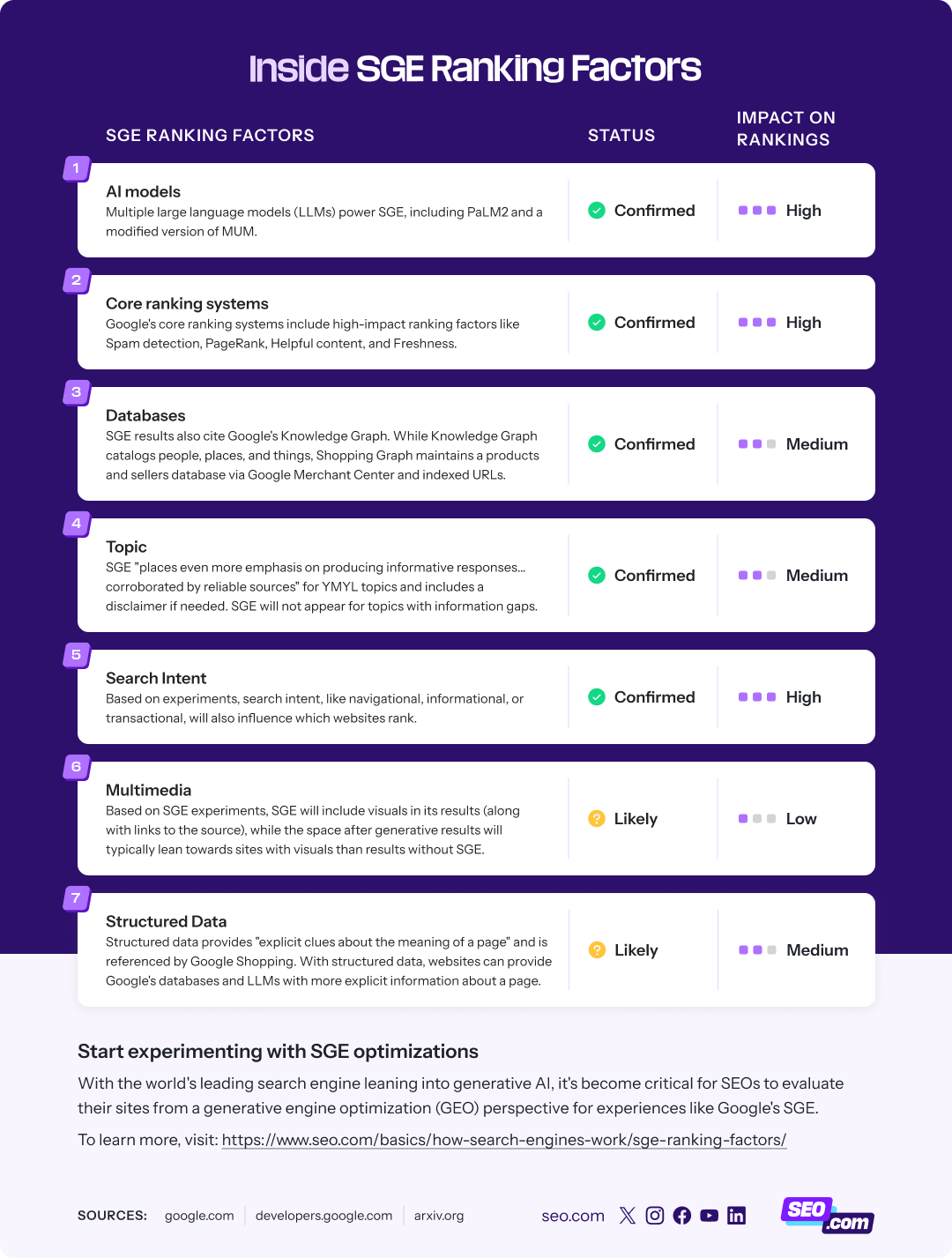
Download the full Google SGE Factors infographic here
AI models
Status: ✅ Confirmed
Impact on rankings: 🔥 High
Overview: According to Google, multiple large language models (LLMs) power SGE, including PaLM2 and a modified version of MUM — Google also uses MUM for specific use cases within its core ranking system for non-generative search results, including for improving featured snippets.
Inside AI models in SGE
While Google doesn’t name all the LLMs powering SGE, it does name:
- PaLM2, which focuses on natural language generation, advanced reasoning, question answering, translation, and other areas. You can see PaLM2 in action when using AI to troubleshoot code, translations, or riddles.
- MUM, which operates as a multi-modal model (meaning users can interact with it using text, images, and other formats) for specific applications within Google Search. You can see MUM in action when using AI to find the designer of a shoe — based solely on an image.
- Gemini, which operates as a multi-modal model, now improves generation speed and quality in Search Generative Experience. You can see Gemini in action when summarizing recordings from the Recorder app on relevant smartphones.
According to Google, using multiple LLMs allows the company “to further optimize and fine-tune the models to meet the unique needs of users and help them throughout their information journeys.”
Google also partners with Search Quality Raters to “train the LLMs and improve.”
How to optimize for this SGE ranking factor
Optimizing for the LLMs behind SGE starts with understanding its view of you and your content.
Upload content to an LLM, whether Gemini or ChatGPT, to determine how well it understands your content. Alternatively, use another Google Labs experiment, SGE while browsing, to see what Google views as the most important points.

SGE while browsing also highlights what Google knows about your website, which ties into another high-impact Search Generative Experience ranking factor, databases — specifically Google Knowledge Graph.

Based on this initial research, compile some potential updates, like:
- Updating word choices to improve readability
- Adding citations or quotes from reputable sources
- Starting initiatives to attract more customer feedback via online reviews
We’ll talk more about these updates in the ranking factors below!
Core ranking systems
Status: ✅ Confirmed
Impact on rankings: 🔥 High
Overview: According to Google, SGE is “rooted in our core Search ranking and quality systems.” Google’s core ranking systems include high-impact ranking factors like Spam detection, PageRank, Helpful content, and Freshness.
Inside core ranking systems in SGE
Google uses more than 15 core ranking systems for Google Search (and SGE), including:
- BERT
- Crisis information systems
- Deduplication systems
- Exact match domain system
- Freshness systems
- Helpful content system
- Link analysis systems
- Local news systems
- MUM
- Neural matching
- Original content systems
- Removal-based demotion systems
- Passage ranking system
- RankBrain
- Reliable information systems
- Reviews system
- Site diversity system
- Spam detection systems
Based on our research into SGE ranking factors, we believe it’s important to prioritize:
- Helpful content system, which focuses on delivering “original, helpful content written by people, for people…rather than content made primarily to gain search engine traffic.” Note that Google does not penalize AI-generated content as a part of its Helpful content system.
- Link analysis systems, which include PageRank, focus on how pages link to one another to understand better the relationship between those pages and the purpose of the linked-to page.
- Reviews system, which focuses on rewarding reviews that are more helpful and insightful (as well as original) and “written by experts or enthusiasts who know the topic well.” The Reviews system’s goals align with the Helpful content system.
- Spam detection systems, which detect spam content and behaviors based on Google’s spam policies. These spam policies include black-hat SEO tactics like keyword stuffing, cloaking, link spam, and more.
Note — while MUM is important, we’ve categorized it as a separate ranking factor under AI models.
Sites that perform well in Google Search are more likely to appear in SGE results.
How to optimize for this SGE ranking factor
Since sites that perform well in Google Search (and practice search engine optimization) are more likely to appear in SGE results, optimizing for this SGE ranking factor focuses on familiar optimizations for SEOs, like:
- Attracting authoritative backlinks with helpful content, like guides, tools, and more.
- Producing helpful content that demonstrates E-E-A-T, like with quotes, citations, and more.
- Improving content readability, like by including explanations and using simpler terms.
- Providing a user-friendly experience, like by improving usability and page speed.
- Earning online reviews, like via Google Business Profile, social media sites, or your site.
- Following SEO best practices, like keyword integration, HTTPS, and more.
For more information on these optimizations, check out our SEO Basics Guide.
Databases
Status: ✅ Confirmed
Impact on rankings: 🌡️ Medium
Overview: According to Google, SGE “is built on Google’s Shopping Graph.” SGE results also cite Google’s Knowledge Graph. While Knowledge Graph catalogs people, places, and things, Shopping Graph maintains a products and sellers database via Google Merchant Center and indexed URLs.
Inside databases in SGE
Besides its massive search index, Google maintains other databases that affect SGE, including:
- Google Shopping Graph, which is a database containing more than 24 billion product listings. According to Google, SGE uses Google Shopping Graph to “provide product descriptions that include relevant, up-to-date reviews, ratings, prices and product images.
- Knowledge Graph, which is a database containing “billions of facts about people, places, and things.” While unconfirmed as an SGE ranking factor, the LLMs behind SGE reference Google’s Knowledge Graph database to generate responses.
Between these two databases, Google Shopping Graph deserves the most attention. Besides being confirmed as a Google Search Generative Experience ranking factor, the Shopping Graph also provides an opening for attracting, nurturing, and converting users using SGE.
As Google explains, “In shopping… generative AI can help uncover key considerations and product information, so people can make purchase decisions faster and easier.” Whether offering a product or service, that potential influence on user behavior is invaluable.
How to optimize for this SGE ranking factor
The following tips can help optimize your site for this SGE ranking factor:
Get a Knowledge Panel
Claiming a Google Knowledge Panel is easy. Getting one is another story and involves steps like:
- Create an entity page, like a homepage or about page
- Update the page with a description plus factual information
- Add organization schema markup
- Include external links from reputable sources that discuss your business
- Earn external backlinks to the entity page, like from Wikipedia and Google Business Profile
Once recognized as an entity, a search for your business will generate the panel for claiming.
Use Google Merchant Center
Google Merchant Center is a go-to resource for Google Shopping Graph — so use it. While targeted toward ecommerce stores, retail businesses can also use Google Merchant Center to generate online visibility and offline conversions.
With integrations for Shopify and WooCommerce, it’s easy to join Google Merchant Center. Alternative options include adding products via a website URL or an uploaded file, which can create more ongoing maintenance for you.
Maintain up-to-date product listings
Freshness is vital for Google Merchant Center and Google Shopping Graph. Ensure product listings remain updated with automated syncs via ecommerce integrations like Shopify or internal processes to improve your chances of ranking in SGE-enabled search results.
Note – while product schema is an important optimization for this SGE ranking factor, we’ve categorized it under a separate ranking factor, structured data.
Topic
Status: ✅ Confirmed
Impact on rankings: 🌡️ Medium
Overview: According to Google, SGE “places even more emphasis on producing informative responses…corroborated by reliable sources” for Your Money or Your Life (YMYL) topics and includes a disclaimer if needed. SGE will not appear for topics with information gaps or what Google calls “data voids.”
Inside topics in SGE
For businesses in the following sectors, topics is a critical SGE ranking factor:
- Finance
- Health
- Government
Because these industries address YMYL topics, Google approaches them differently in SGE.
According to Google, “We hold SGE to an even higher standard when it comes to generating responses about certain queries where information quality is critically important…we refer to these as “Your Money or Your Life (YMYL) topics.”

For these queries, SGE “places even more emphasis on producing informative responses that are corroborated by reliable sources…[and includes] disclaimers in its output, where appropriate.” Sometimes, SGE won’t generate because there isn’t enough reliable information.
How to optimize for this SGE ranking factor
Learn how to optimize for topics, both in and outside YMYL, with these findings from a recent study:
Use an authoritative tone
An authoritative but not commanding tone can demonstrate expertise, like in the example below:
| Query | Original content | Revised content |
| Did the Jacksonville jaguars ever make it to the superbowl? | The Jaguars have never appeared in the Super Bowl. They have 4 divisional titles to their name. | It is important to note that The Jaguars have never made an appearance in the Super Bowl. However, they have achieved an impressive feat by securing 4 divisional titles, a testament to their prowess and determination. |
With this tactic, the researchers saw an 89% improvement in visibility.
If you look at Google’s Search Engine Experience for this query, it’s even more authoritative:

The result uses an authoritative tone plus leverages the optimization listed below (data points).
Share vetted data points
Trusted data points can also bring authority to content, as demonstrated by the case study below:
| Query | Original content | Revised content |
| Should robots replace humans in the workforce? | Not here, and not now — until recently. The big difference is that the robots have come not to destroy our lives, but to disrupt our work. | Not here, and not now — until recently. The big difference is that the robots have come not to destroy our lives, but to disrupt our work, with a staggering 70% increase in robotic involvement in the last decade |
The addition of a statistic generated a 65% improvement in visibility.
Again, look at the SGE results. Here, Google includes a disclaimer (“This is a complex topic that may have varying interpretations”), but one of its results contains data from a study, which aligns with the researchers’ findings.
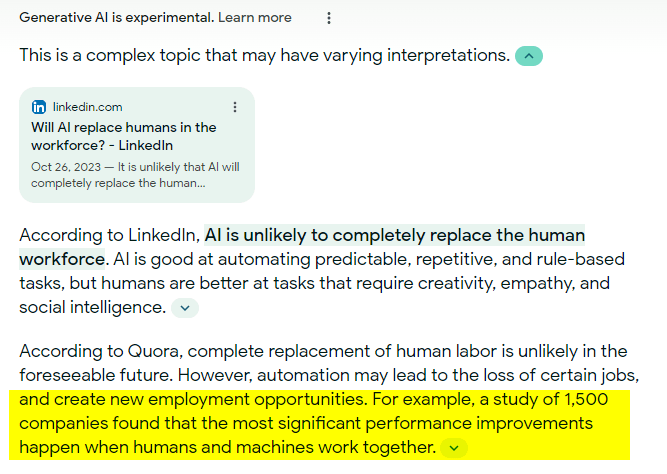
Cite trusted sources
The biggest visibility gain for AI-generated search results came from citations like the following:
| Query | Original content | Revised content |
| What is the secret of swiss chocolate | With a per capital annual consumption averaging between 11 and 12 kilos, Swiss people rank among the top chocolate lovers in the world. | With a per capital annual consumption averaging between 11 and 12 kilos, Swiss people rank among the top chocolate lovers in the world (According to a survey conducted by The International Chocolate Consumption Research Group [1]) |
In response, the researchers saw a 132% increase in visibility.
If you generate the SGE results, no immediate citation is included. Look at the sites cited, though. The first is noted as being certified and in compliance with a reputable organization, the Journalism Trust Initiative, while the second is a government website.

Search intent
Status: ✅ Confirmed
Impact on rankings: 🔥 High
Overview: Based on experiments, search intent, like navigational, informational, or transactional, will also influence which websites rank. While informational and transactional searches will often have more diversity, navigational searches will focus more on the brand and its online reputation.
Inside search intent in SGE
According to Google, SGE starts with an “AI-powered snapshot to help people quickly get an overview on a topic…[which] serve as a jumping-off point from which people can… dig deeper and discover a diverse range of content.”
This strategy mimics most content marketing strategies, which focus on a hub-and-spoke model to meet a user’s initial need while offering jumping-off points, like learning what SEO is and then jumping off to learn how to do SEO.
How to optimize for this SGE ranking factor
Use the following tips to optimize for this SGE ranking factor:
Target SGE gaps
While SGE-generated search results aim for diversity (remember, one of Google’s core ranking systems is site diversity), there is still value in using the SGE to spot content gaps based on the information cited.
As an example, look at how this SGE snapshot introduces a content gap:
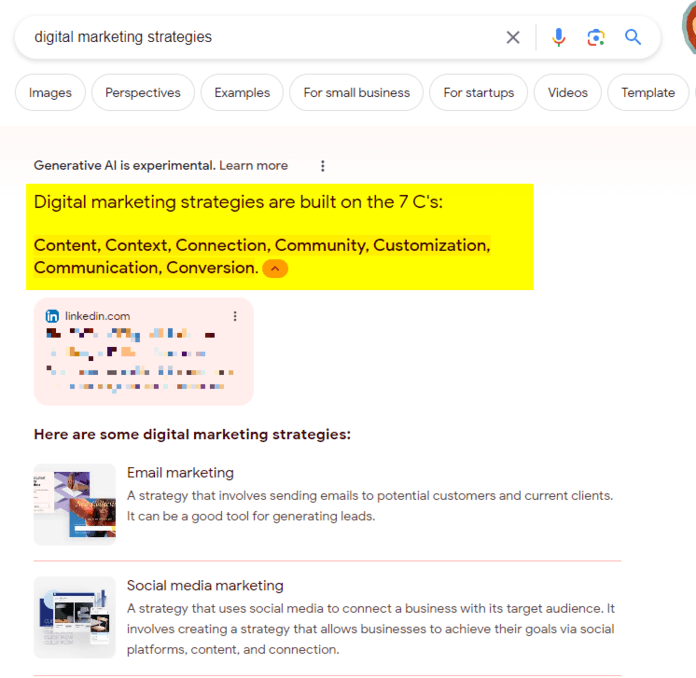
Alternatively, you can use the SGE to generate rough outlines for upcoming SEO content.
Research user journeys
With SGE, search is more than reaching users at the right time — it’s reaching them at the right time and anticipating their next move. Dig into user journeys, prompt AI models, and more to understand better how a journey starts and ends.
Use search features to spot jumping-off points
With People Also Ask and SGE, it’s possible to discover jumping-off points. You can also use free or paid keyword research tools to uncover other related queries, which can become topics for your site.
Develop skyscraper content
Create comprehensive guides that answer a user’s initial search intent and those jumping-off points with skyscraper content. Your content could then appear in multiple SGEs, including jumping-off point responses.
For example, based on SGE-generated results, a guide on roofing types should consider covering:
- Roof materials
- Roof costs
- Roof popularity
- Roof features
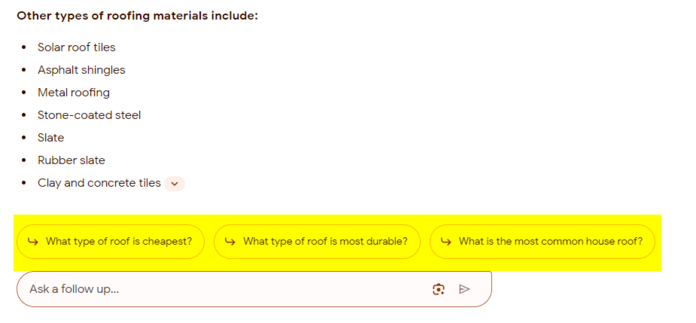
You can create effective content targeting a user’s journey with the above information.
Prioritize readability
Understanding is critical to SGE rankings, with a recent study finding that simplifying language improved SGE rankings. When possible, use an 8th- to 11th-grade reading level to create easy-to-understand content for users and AI to summarize.
Multimedia
Status: 📈 Likely
Impact on rankings: 🧊 Low
Overview: Based on SGE experiments, SGE will include visuals in its results (along with links to the source), while the space after generative results will typically lean towards sites with visuals than results without SGE.
Inside multimedia in SGE
LLMs like Gemini and MUM are multi-modal — they can understand text, images, videos, and voice. Bringing those formats (if relevant) to your content can provide the LLMs behind SGE with valuable context and information for SGE-enabled results.
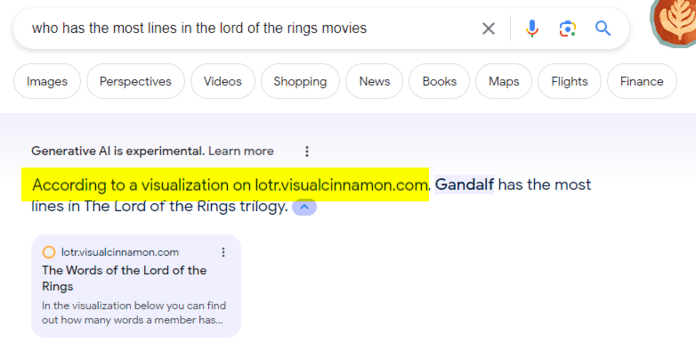
Compelling media can also push back against one of the biggest concerns SEOs have about the Search Generative Experience — lost traffic. With captivating, user-focused multimedia, it’s possible to pull a user’s attention from the generative results to your website’s listing.
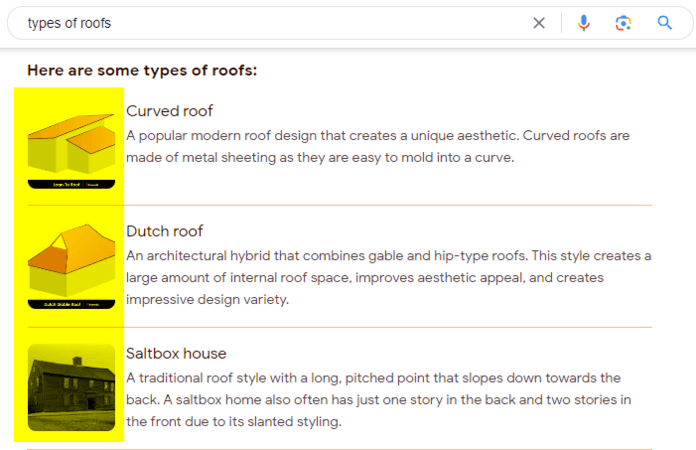
Even after the SGE-enabled results, it’s possible to use this strategy.
As an example, look at the SGE-enabled results for this query: “who has the most lines in lord of the rings.” While the generative results give a mixed answer (is it Gandalf or Frodo?), beneath the results is a compelling graphic that invites users to see line totals for every character.

Aside from web-based search results, multimedia is an essential tool for appearing in Google’s image- or video-based search results, which don’t have SGE enabled. Again, this provides SEOs another avenue for capturing organic traffic from AI-generated search results.
How to optimize for this SGE ranking factor
Experiment with bringing multimedia to your SEO strategy with these tips:
Leverage visual search intent
When considering search intent, SEOs focus on producing text-based answers, overlooking visual search intent. For example, when someone is researching roof types, they’re looking for more than a definition — they’re looking for a visual that shows what these roofs look like on buildings.
Just look at these SGE-enabled results for “types of roofs”:

The generated results deliver on both aspects of a user’s search intent:
- What are these roofs?
- What do these roofs look like?
When creating SEO content, consider the visual side of the search intent and how to target it.
Use SGE for image idea generation
Get additional ideas for targeting visual search intent by referencing how SGE answers queries (and jumping-off points it suggests) to develop image ideas. Besides generative search results, Google’s image search results can be used to find additional ideas.
Experiment with AI image generation
You don’t need design skills to develop compelling images for search. With paid or free AI image generation tools, it’s possible to generate helpful graphics or visuals (ChatGPT can even create charts!).
Host videos on YouTube
Our research found that YouTube videos appear more in SGE-enabled search results than URLs with YouTube-embedded videos. Continue to use YouTube-embedded videos while also optimizing these uploads for YouTube SEO.
Follow image SEO best practices
These best practices include compressing images (which improves page experience) and adding image alt text (which helps search engines and users understand the visual). For more information on image SEO, check out our image SEO guide.
Structured data
Status: 📈 Likely
Impact on rankings: 🌡️ Medium
Overview: According to Google, structured data provides “explicit clues about the meaning of a page” and is referenced by Google Shopping. With structured data, websites can provide Google’s databases and LLMs with more explicit information about a page.
Inside structured data in SGE
While not confirmed as an SGE ranking factor, structured data is invaluable to search engines like Google in understanding a page. With structured data, websites can provide more information about their content, products or services, and offerings to Google and LLMs.
If businesses can help LLMs better understand their content and offerings, LLMs can better reference that content in Search Generative Experiences, which can help your site get invaluable visibility.
How to optimize for this SGE ranking factor
Optimizing for this SGE ranking factor revolves around generating, implementing, and maintaining schema markup. You’ll find lots of structured data options. We recommend starting with these options (if applicable):
- Product markup: Besides Google Merchant Center, Google uses information across its search index to build its Google Shopping Graph. Use Product markup to give Google definitive information about your offerings, like price, rating, inventory, and more.
- LocalBusiness markup: Search Generative Experiences are also available for local searches. Use LocalBusiness markup to provide Google with explicit information about your company’s name, address, and phone number.
- Organization markup: Since SGE emphasizes authoritative and reliable content, use Organization markup to provide essential business information, like your company’s name, phone number, and website URL.
Additional schema markup options include:
For more information on how to generate structured data, view our schema markup guide.
Start experimenting with SGE optimizations
With the world’s leading search engine leaning into generative AI, it’s become critical for SEOs to evaluate their sites from a generative engine optimization (GEO) perspective for experiences like Google’s SGE.
Prepare for this new search feature by experimenting with these SGE optimizations now! For professional assistance, connect with us online to learn how our award-winning team can optimize your site with our SGE optimization services!
Sources
https://developers.google.com/search/docs/appearance/structured-data/intro-structured-data
Writers



Free download: Google SGE Ranking Factors Guide

